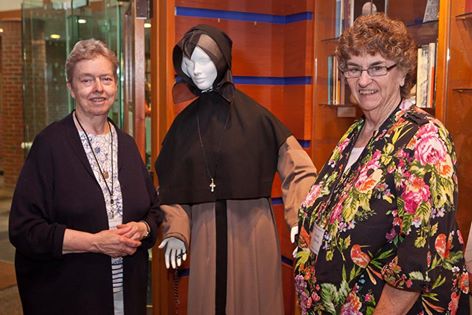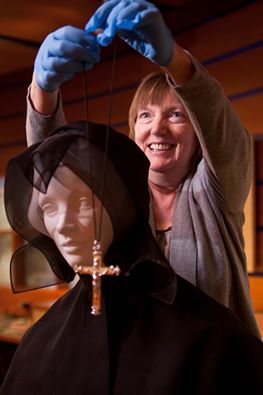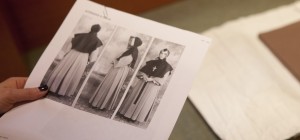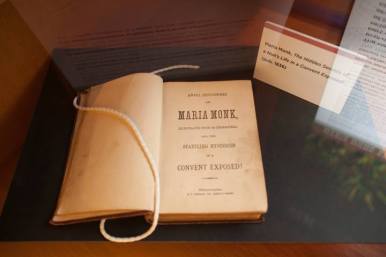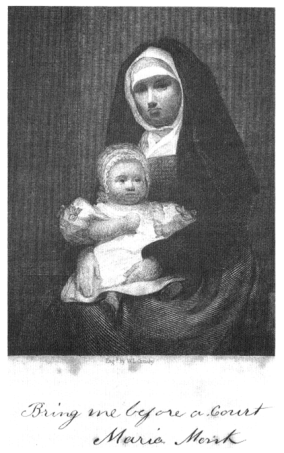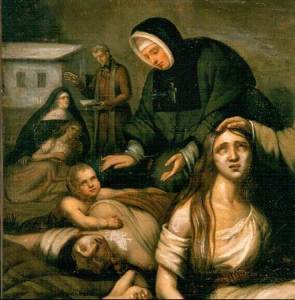Grey Nuns at “Women and the Great Hunger in Ireland” Conference, Quinnpiac University, June 5, 2015
by irishcanadianfamineresearcher
From Ireland’s Great Hunger Institute, Quinnipiac University:
Among our more than 50 guests at our “Women and the Great Hunger in Ireland” conference are Sister Marlene Butler GNSH, left, of Yardley, Penn., and Sister Anne… Marie Beirne GNSH, of Queens, N.Y. The Grey Nuns of the Sacred Heart visited our year-long “Saving the Famine Irish: The Grey Nuns and the Great Hunger” exhibit in the Arnold Bernhard Library. “It’s absolutely wonderful,” Sister Butler said. “We try to create a more compassionate world — and it’s really inspiring to see what the Grey Nuns accomplished in Montreal.” Sister Beirne said the exhibit demonstrates how much we can all help each other. “Just hearing the stories is so emotional.” She is continuing the work of her predecessors by volunteering her time at Marguerite’s Pantry in New York. “It’s living a life of compassion,” she said. “That’s what they called us to do.” Read more: http://bit.ly/1G0s2Ab
During their visit Dr. Jason King delivered a keynote address entitled “Sacred and Sacrilegious Women’s Testimonials: The Grey Nuns and Maria Monk, Famine Irish Migrants, and the Montreal Fever Sheds in 1847-1848″.
He suggested that the sacred images and religious iconography of French-Canadian and Irish female religious caring for Montreal’s Famine emigrants in the “Saving the Famine Irish” exhibit were directly influenced and shaped by the sinister impressions of Maria Monk a decade earlier, which they sought to repudiate and replace. In the decade before the Irish Famine influx into Montreal in 1847, the very same orders of priests and nuns who cared for Irish emigrants and rescued Famine orphans had become figures of infamy following the publication of The Awful Disclosures of Maria Monk, or, the Hidden Secrets of a Nun’s Life in a Convent Exposed (1836). Her purported autobiographical account of her experiences within and escape from the Hôtel Dieu convent was a staple of American nativism and a best-seller, with over three hundred thousand copies purchased by 1860 – second only to Harriet Beecher Stowe’s Uncle Tom’s Cabin in the antebellum United States. In her Awful Disclosures, Maria Monk claimed to have been incarcerated in Montreal’s Hôtel Dieu convent in which she alleged that acts of sexual abuse and infanticide routinely occurred, although her allegations were comprehensively discredited in the years that followed.
It is profoundly ironic that the very same priests and nuns who were vilified by Maria Monk in 1836 for plotting to murder helpless Irish infants became iconic figures and venerated in popular memory a decade later for their salvation of Famine orphans. In fact, this tension between sacred and sacrilegious, or iconic and idolatrous images of women and children was embodied in the figures of the uncloistered nun with the Irish infant, which provided a focal point for the popular memory of Maria Monk as well as the fever sheds. Ultimately, it was only by forgetting the sacrilegious figure of Maria Monk that the sacred memory of the clergy and female religious who cared for Irish emigrants in Montreal’s fever sheds could be preserved and transmitted.
